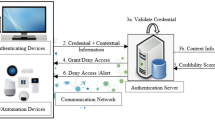Abstract
Recently, mobile devices such as smartphones and tablets have emerged as one of the most popular forms of communication. This trend raises the question about the security of the private data and communication of the people using those devices. With increased computational resources and versatility the number of security threats on such devices is growing rapidly. Therefore, it is vital for security specialists to find adequate anti-measures against the threats. Machine Learning approaches with their ability to learn from and adapt to their environments provide a promising approach to modelling and protecting against security threats on mobile devices. This paper presents a comparative study and implementation of Decision Trees and Neural Network models for the detection of port scanning showing the differences between the responses on a desktop platform and a mobile device and the ability of the Neural Network model to adapt to the different environment and computational resource available on a mobile platform.
Access this chapter
Tax calculation will be finalised at checkout
Purchases are for personal use only
Preview
Unable to display preview. Download preview PDF.
Similar content being viewed by others
References
Khan, S., Nauman, M., Othman, A.T., Musa, S.: How secure is your smartphone: An analysis of smartphone security mechanisms. In: Proceedings of the 2012 International Conference on Cyber Security, Cyber Warfare and Digital Forensic (CyberSec), June 26-28, pp. 76–81 (2012)
Zaman, S., Karray, F.: TCP/IP Model and Intrusion Detection Systems. In: Proceedings of the International Conference on Advanced Information Networking and Applications Workshops, Bradford, United Kingdom, May 26-29, pp. 90–96 (2009)
Kou, X., Wen, Q.: Intrusion detection model based on Android. In: Proceedings of the 4th IEEE International Conference on Broadband Network and Multimedia Technology (IC-BNMT), pp. 624–628 (2011)
Ghorbanian, M., Shanmugam, B., Narayanasamy, G., Idrids, N.: Signature-Based Hybrid Intrusion detection system (HIDS) for Android devices Business Engineering and Industrial Applications Colloquium (BEIAC), April 7-9, pp. 827–831. IEEE (2013)
Fahlman, S.E., Lebiere, C.: The cascade-correlation learning architecture. In: Touretzky, D.S. (ed.) Advances in Neural Information Processing Systems 2, pp. 524–532. Morgan Kaufmann Publishers Inc., San Francisco (1990)
Govindarajan, M., Chandrasekaran, R.M.: Intrusion detection using k-Nearest Neighbor. In: Proceedings of the First International Conference on Advanced Computing ICAC, December 13-15, pp. 13–20 (2009)
Jie, Y., Chen, X., Xiang, X., Wan, W.: HIDS-DT: An Effective Hybrid Intrusion Detection System Based on Decision Tree International Conference on Communications and Mobile Computing, April 12-14, pp. 70–75 (2010)
Gates, C., Taylor, C.: Challenging the anomaly detection paradigm: a provocative discussion. In: Proceedings of the Workshop on New Security Paradigms (NSPW 2006), New York, USA, pp. 21–29 (2006)
Denning, D.E.: An Intrusion-Detection Model. In: Proceedings of the IEEE Symposium on Security and Privacy, pp. 118–133 (1986)
Mitchell, R., Chen, I.-R.: “Behavior-Rule Based Intrusion Detection Systems for Safety Critical Smart Grid Applications. IEEE Transactions on Smart Grid 4(3), 1254 (2013)
Yang, Y., McLaughlin, K., Littler, T., Sezer, S., Wang, H.F.: Rule-based intrusion detection system for SCADA networks. In: 2nd IET Renewable Power Generation Conference (RPG 2013), September 9-11, pp. 1–4 (2013)
Boyer, R.S., Moore, J.S.: A Fast String Searching Algorithm. Comm. ACM 20(10), 762–772 (1977)
Antonatos, S., Polychronakis, M., Akritidis, P., Anagnostakis, K.G., Markatos, Y.E.P.: Fast and Memory-Efficient Pattern Matching for Intrusion Detection. In: Proceedings 20th IFIP International Information Security Conference SEC (2005)
Bhuyan, M., Bhattacharyya, D.K., Kalita, J.K.: Surveying Port Scans and Their Detection Methodologies. Computer Journal ACM 54, 1565–1581 (2011)
Dabbagh, M., Ghandour, A.J., Fawaz, K., Hajj, W.E., Hajj, H.: Slow port scanning detection. In: Proceedings of the 7th International Conference on Information Assurance and Security (IAS), December 5-8, pp. 228–233 (2011)
Wang, G., Hao, J., Ma, J., Huang, L.: A new approach to intrusion detection using Artificial Neural Networks and fuzzy clustering. Expert Systems with Applications 37(9), 6225–6232 (2010)
Nazir, A.: A comparative study of Cascaded Forward Back Propagation and Hybrid SOFM-CFBP Neural Networks based Intrusion Detection Systems. International Journal of Scientific and Engineering Research 4(6) (2013)
Basu, R., Cunningham, R.K., Webster, S.E., Lippmann, R.P.: Detecting low-profile probes and novel denial-of-service attacks. In: Proceedings of IWIAS 2001, West Point, New York, USA, pp. 5–10. IEEE Computer Society (June 2001)
Oke, G., Loukas, G., Gelenbe, E.: Detecting denial of service attacks with bayesian classifiers and the random neural network. In: Proceedings of FUZZ- IEEE 2007, pp. 1964–1969. IEEE, USA (2007)
Fisch, D., Hofmann, A., Sick, B.: On the versatility of radial basis function neural networks: A case study in the field of intrusion detection. Information Sciences 180(12), 2421–2439 (2010)
Kalpana, Y., Purushothaman, S., Rajeswari, R.: Implementation of Echo State Neural Network and Radial Basis Function Network for Intrusion Detection. Data Mining and Knowledge Engineering 5(9), 366–373 (2013)
Author information
Authors and Affiliations
Editor information
Editors and Affiliations
Rights and permissions
Copyright information
© 2014 Springer International Publishing Switzerland
About this paper
Cite this paper
Panchev, C., Dobrev, P., Nicholson, J. (2014). Detecting Port Scans against Mobile Devices with Neural Networks and Decision Trees. In: Mladenov, V., Jayne, C., Iliadis, L. (eds) Engineering Applications of Neural Networks. EANN 2014. Communications in Computer and Information Science, vol 459. Springer, Cham. https://doi.org/10.1007/978-3-319-11071-4_17
Download citation
DOI: https://doi.org/10.1007/978-3-319-11071-4_17
Publisher Name: Springer, Cham
Print ISBN: 978-3-319-11070-7
Online ISBN: 978-3-319-11071-4
eBook Packages: Computer ScienceComputer Science (R0)




